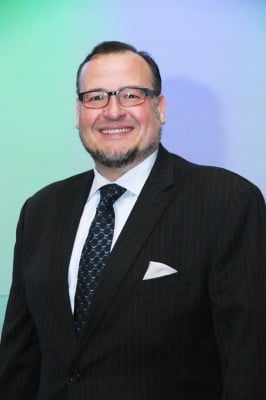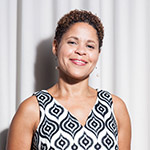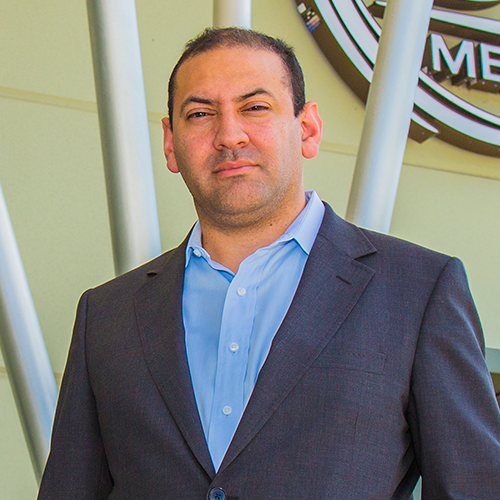
Director of Procurement,
Fannie Mae
“My father is the most responsible person I‘ve ever met. There was a lot to be learned from him. When my parents came to the US from Puerto Rico, they were young and had little education, but had strong desire to create a better future for me. They’ve always been supportive of my career—even when they were somewhat perplexed by what I was doing. That’s part of being Latino: having family as your touchstone. It’s an integral part of who I am.
I was born and raised in Chicago, got my BA in History from Yale, and my MBA from the University of Illinois at Chicago. I spent a year working at City Colleges, assisting newly legalized immigrants in obtaining permanent resident status or citizenship. In the midst of it all, I did an internship at GE Capital, and I’ve been in community development ever since.
I’ve worked at Accion Chicago—a micro-lending program partnered with Banco Popular. I’ve also worked at the Hispanic Housing Development Corporation, the McCormick Tribune YMCA, and at the Northern California Supplier Development Council certifying minority-owned businesses and attempting to connect them with business opportunities at Fortune 500 companies. It felt like a natural fit when I joined Fannie Mae five years ago as a director of corporate procurement.
Fannie Mae provides large-scale access to affordable mortgage credit to assist in buying, renting, or refinancing homes. Each year, Fannie Mae has $4 billion of what we deem ‘procurable spending’—that’s spending where we can influence the selection of the supplier. I was hired to be the director of the corporate supplier diversity program, but I wear other hats, too. I am responsible for reporting and compliance within the procurement group as well as overseeing policy and procedure for the group. In truth, I’m like the free agent in the procurement group. If people aren’t sure where it resides, it tends to end up in my office.
‘Supplier diversity’ means considering and utilizing diverse-owned businesses to deliver goods and services to our company. In the strictest sense of the definition, per the Housing and Economic Recovery Act, this includes businesses that are minority-owned, woman-owned, and disabled-owned. However, we also consider others such as LGBT-owned and veteran-owned. The idea is to direct resources to underserved populations.
Having a diverse supply chain tends to have a positive impact on our bottom line as well. You get increased competition and increased innovation, and access to skills and resources you might not get with a static supply chain. The diverse-supplier spectrum that we engage with includes real estate professionals, companies that repair and maintain properties, professional services firms, consulting firms, and IT firms. We want real estate professionals and property preservation suppliers who represent the communities they serve.
To help identify prospective diverse suppliers, my team participates in over 50 meetings, workshops, and trade shows across the country each year. We partner with a number of industry groups so we can inform their constituencies about prospective opportunities with Fannie Mae. Some of our partners are the Women’s Business Enterprise National Council, the National Minority Supplier Development Council, the United States Business Leadership Network (a disabled-owned advocacy group), and the National Association of Hispanic Real Estate Professionals.
Fannie Mae is in conservatorship now and needs to follow the mandate of its conservator, the Federal Housing Finance Agency. Early on, I had to begin building a program compliant with the new regulations that went into effect in January 2011. We had to track our spending, produce auditable numbers, and comply with all the pieces of the regulations. And we did that. At first, a lot of our effort was focused on supplier outreach—letting people know the opportunities that were here. But at some point, you have to move beyond outreach and look at supplier development. That’s the direction we’re moving in.
Holding supplier summits was the first big step. We surveyed participants about their businesses to see if they were viable prospective suppliers for Fannie Mae. Then we engaged our internal stakeholders about clear areas of opportunity and showed them the information we had gathered so they could identify good potential candidates. At our Credit Portfolio summit in Dallas, for example, about fifty suppliers participated along with fifteen or twenty of our existing business partners who had opportunities available. The idea was to drive business to the suppliers. As a result of the summit, more than 30 contracts were executed between the suppliers and Fannie Mae and/or our business partners. We did our homework—it wasn’t just a cold ‘meet and greet.’ It was clearly more productive for everyone this way.
The challenges we currently face often involve setting expectations. There’s sometimes a disconnect between our actual needs and the perception of such. Everyone wants a piece of the pie, but there’s only so much pie to go around, and we have to let people know that. We also have to communicate that we are actually not a government-owned agency, so the rules are different. Internally, on the other hand, one challenge is to convince key stakeholders to consider some suppliers they might not otherwise have considered, which sometimes takes a little nudge.
What’s rewarding about this job is that we know we’re doing the right thing. It’s not just a social responsibility issue; there is a large measure of self-interest, too. We are increasing our ability to perform effectively. There is nothing sacrificed by bringing in a diverse supplier. In fact, there are often cost and/or production benefits from doing so.
We are directing resources to communities that have traditionally lacked access to some of those resources. We’re making sure there are jobs to support communities and families. There is a positive, tangible outcome of what we do. We are making a difference.”

